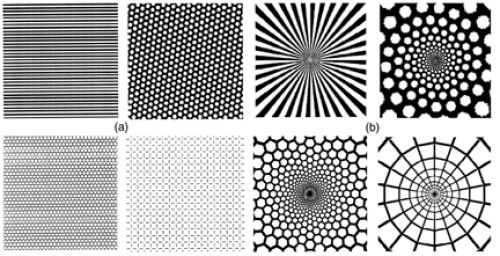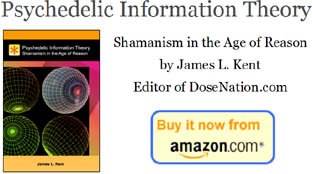I have been locked down in mad-scientist mode for the last few weeks working on the latest version of my theory of psychedelic action, and for those of you who are interested there is a
review version available in PDF form.
The multi-state theory is an extrapolation of what I called signal theory, or the theory that runaway feedback in sensory circuits is responsible for many of the perceptual effects of psychedelics. The multi-state theory expands on this notion, breaking down the effects of psychedelics at various dose ranges into stages of cortical network excitation, destabilization, feedback overload, complete cortical decoupling, and subsequent cortical resynchronization at an optimized high-energy phase state. It is my assertion that the process of cortical decoupling and subsequent resynchronization at an optimized phase-state is the most poorly understood event in the psychedelic experience; yet this is the very process that makes psychedelics so mystical, powerful, and useful for facilitating novel and unique expanded mind states.
Most of the paper is pretty technical, so if you have questions feel free to ask.






















but it's definitely a mistake to think that what magic or God or the Tao or spirit is can be explained as a mechanistic process that gives an impression that it's beatific and so forth, just because it's causing a perceptual effect. There's too many variables that remain unknown about the fundamentals of existence itself, to be using a nervous system and what's thus far been programmed or learned into it, to be explaining everything about how such things operate.
I don't actually think that even if it was entirely possible to explain everything by particle and wave interactions, that'd it be any less magical anyway - we'd still be left unable to explain how to replicate such an occurance as a universe of particles and waves, and then also remain unable to fully if at all explain how any first version was able to come into being, if indeed there's ever been a first version. Cause if it's infinite then there can't be a first overall existence. Maybe the best approach is to take it as if we're the equivalent to computers in some possible future; humans are all gone and are the stuff of myths only, and there are some self-aware machines who are seeking to explain how their hardware and software work and who/what made it and where it came from. Even if they figure it all out, they don't then have answers about the origins and purpose etc of those who made them, nor of what the nature of the world they are in is all about. It's also not easy to get definite answers on biological processes in vitro, because there's no guarantee they behave that way in vivo; and at that, everyone's different. It's not really the same as being able to monitor a network - we made those. Machines are modular, people are not.
You can't possibly know what they are experiencing. Having said that, I'm not really sure what you mean anyway....are people thesedays unable to just trip anymore without there being someone else there who isn't on anything. I know I mentioned the Harvard book, but I wasn't talking about the guide part....as far as I remember, the point of the guide is someone who isn't tripping being there just in case the tripper goes off their head; the guide can't be someone that hasn't walked the path beforehand, or they can't keep the newly-tripping person on the path. That'd be as much use as claiming to be an exorcist or demonologist, without ever having any experience at all of encountering any such forces.
Or just hire a sherpa or the likes who's never been in the area before either. How can you assess a situation without knowing about it first hand. What the hell do you think this is.
Yes, it's a bit dense for the layperson and would require at least two readings to soak up the meaning. Nut what is apparent to me is that the psychedelic experience is uniquely complex right down to the synaptec, these drugs are NOT "one trick ponies". This research is also important since (from what I can tell), it's the only scientific research soundly based on subjective reports. Since one of the major tenets of science is basing findings on publicly observable data, psychedelics - which can only be grokked through personal experience - tends to fall through the cracks of scientific inquiry. I salute James for putting a stick in the sand, bridging the divide, and creating a firm toehold for future research, discussion, and debate. Btw, from what I can tell, none of this research diminishes the personal insights and epiphanies one gains from psychedelic trips, any more than dream research has anything to say about _my_ dreams. There will always be a personal experience for which science can have no comment.
Not saying anything informed or uninformed is surely hard for someone who just enjoys talking, writing and reading, but OK, it's possible to do.
Anyway, please consider that psychedelic guides/sitters do not grow on trees or bushes. And for sure I'm informed enough to know it's too risky to try these substances alone.
Why should I have to excuse myself?
I'd recommend reading the Harvard Bardo Thodol (Alpert, Leary, Metzner)- because it explains how not to let your thoughts colour the experience.
Or trying out a meditation where you watch/are aware of & detached from your thoughts, and applying that kinda thing during the trip. Thoughts can be tricky; maybe you think you are watching the ego - but actually you're watching it from another ego....it's not easy to explain, cause you need a point of view of some kind to explain anything, and the right way to do these compounds is not to have a point of view. One thing psychedelics are great at doing, is they lose the idiot that can infest the thought process - it's the same idiot hanging around there in the back of the mind, no matter who you are.
The idiot I mean is something like 'the mouth' described in the Harvard book - "order! explain all this!" Having said that, & just to re-iterate, alls I was saying is that the background patterns and neural firing patterns ideas (I've heard of them before!) don't really explain what may be going on with all the compounds. Now, I know that you can look at DNA and say it makes many different forms all from 2/4 basic types of base pairs, or look at all molecules and the complex forms they make up and say they're all made from 100 or so basic atomic elements......but what I was getting at is more that what lies behind all of those things - what creates things like atoms and DNA, and what it makes them out of, and things like their purpose within whatever was 'before' or outwith the universe; it'd seem that some of the psychedelics are more about that experience of things, rather than allowing the fundamental basics of this universe(s) to be experienced in a raw state at sensory processing level. Cause it doesn't really matter how small you go, atoms to sub-atomics, to quarks, and then? the next tiny grains - always the fact remains that those come from something that pre-existed them, and followed some kind of pattern or rule themselves to be able to manifest in the way they do; and have generated beings with the sensory recievers capable of seeing all that and considering it.
Shrooms for example seem to be more about thinking outside of this whole entire type of reality - where the building blocks of matter and EM spectrum and so forth here are only one way of making a particular type of world, whereas LSD seems more to be about focusing on the hardware of the nervous system and what this worlds physical forms are (including 'subtle' energies). It's like LSD draws your attention to: how come you're in a body, in a universe, and you don't fully understand how it works?
And shrooms are drawing your attention to an entirely different type of reality from this one - maybe a type of existence where worlds like this are made. But it doesn't end; 'the mouth' won't ever get its final answer. But we can sure chat about the possibilities and refine theories, while we are in here being measured by 'the mouth'.
Have you ever considered that our perceptions are our only way of having any connection between our inner selves and our external world- and if you accept that, how altering these perceptions we both become more aware of their existence, how reliant our orientation in the universe and sense of reality is on them? personally I think that is the basis of the revelatory nature of the psychedelic experience and is what I have taken from it. Of course, one can make metaphysical arguments about if we're separated or anything, but I'm playing scientist's advocate here =] Also, figure 3 really does have the appearance of a low dose psychedelic experience- trippy! Keep up the good work, this was geeky enough to keep me away from the season finale of Desperate Housewives
Not having any experience with psychedelics yet, I won't dare to comment the theory itself (only a little comment to zupakomputer: I wouldn't say that James is reducing the visual aspect of the psychedelic experience to "just" the patterns shown above, they rather represent something to begin with), so let me comment the "formal" side instead. Is this paper meant to be published as a completely scientific work? If yes, I would advise you to try reducing the content of slang a bit... for example by noting that "trip" is a handy but colloquial term for the psychedelic experience. Or another similar problem: I can't find the sentence anymore, but there was something about "most visual psychedelics" there (or something like that). OK, we psychedelicists (both theoretical and practical ;)) understand what is meant, but still it's quite inexact. More precisely (some) effects are visual and not the substance itself...
OK, that was my hole-picking. ;) Despites this, I think the paper really is extremely interesting and convincing.
I wouldn't even know how to begin to describe them; they're wholly other worlds. No CGI or fantasy art or anything is at all like it.
The same happens for me with E (very different from shrooms though); I see whole cartoons (they occur in a different inner-theatre from where something appears if you just think about it, which is different also from where something inner appears in the mind when I visualise it), except they are played speeded up and I don't recognise them from any comics or animations or anything else I've actually seen before or since.
None of these affect how the outside world looks (they don't superimpose over it or mix with it) - with that, there are similarties in how these three substances work but again they are still very different from one another. Except once, with acid, I was watching inner patterns of rotating mosaic kaelidoscopes (the second pattern in the images best describes the template), and they stayed (but opacity was reduced, so I could see through them) when I opened my eyes - but I think that was only because it was in the dark. I was able to change the pattern with each blink, which was interesting. Natural LSD-type compounds, different again (and VERY strange)....salvia - different again. DMT - nothing, except a very odd shift that felt like switching to another universe that looked exactly the same as the one I was in. I only get the geometries on LSD. LSD feels like it's doing something like Defrag does to a hard drive.
The comments posted here do not reflect the views of the owners of this site.